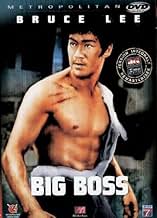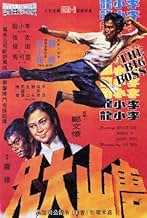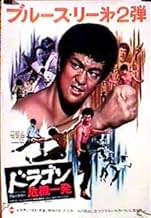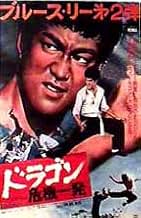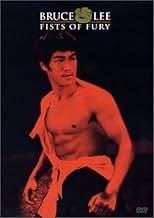CALIFICACIÓN DE IMDb
6.9/10
31 k
TU CALIFICACIÓN
Un joven, que ha hecho un juramento de no violencia, trabaja con sus primos en una fábrica de hielo, donde empiezan a desaparecer misteriosamente.Un joven, que ha hecho un juramento de no violencia, trabaja con sus primos en una fábrica de hielo, donde empiezan a desaparecer misteriosamente.Un joven, que ha hecho un juramento de no violencia, trabaja con sus primos en una fábrica de hielo, donde empiezan a desaparecer misteriosamente.
- Dirección
- Guionista
- Elenco
James Tien
- Hsiu Chien
- (as Paul Tien)
Nora Miao
- Drinkstand owner
- (as Miao Ke Hsiu)
Ying-Chieh Han
- Hsiao Mi (Boss Mi)
- (as Han Ying Chieh)
Hua-Sze Li
- Ah Chai
- (as Li Hua Sze)
Marilyn Bautista
- Miss Wuman
- (as Malalene)
Billy Chan
- Ah Pei
- (as Hui-yi Chen)
Chia-Chen Tu
- Third Uncle
- (as Ka-ching To)
- Dirección
- Guionista
- Todo el elenco y el equipo
- Producción, taquilla y más en IMDbPro
Opiniones destacadas
Saw this in a theatre in 1971 and just revisited it 45 years later.
Conclusion:
As a film, it suffers badly from the massive improvements in choreography, skill, and staging that MA films have enjoyed in the interim. What seemed sort of "OK" in a dark theatre in 1971 becomes, after several decades, almost a slow dance of awkward fighting moves, with off-sync sound effects and blows that never seem to connect with anything.
In this instance it is not fair to judge the old by the new ... so, no rating.
And then there is the topic of Mr. Lee.
History tells us that Bruce Lee exploded into Asian cinema on this film and anyone can see why. IT IS AS IF HE IS OPERATING AT A FAST CAMERA SPEED AND THE REST OF THE CAST AT A SLOW CAMERA FEED. Of course, the speed of the camera is the same throughout, it is the speed of the actors that differed.
The cast were the usual bunch that made many dozens of these films in a year. They looked slow and awkward because they actually were slow and awkward.
Mr. Lee on the other hand lived (and ultimately died) for his craft. His whole life was MA and even today the debate continues as where he would have ranked against the best fighters of all time. At the top is my guess.
In essence, this is almost an audition tape for Mr. Lee and not much else. But it is a piece of history and deserves great respect.
Conclusion:
As a film, it suffers badly from the massive improvements in choreography, skill, and staging that MA films have enjoyed in the interim. What seemed sort of "OK" in a dark theatre in 1971 becomes, after several decades, almost a slow dance of awkward fighting moves, with off-sync sound effects and blows that never seem to connect with anything.
In this instance it is not fair to judge the old by the new ... so, no rating.
And then there is the topic of Mr. Lee.
History tells us that Bruce Lee exploded into Asian cinema on this film and anyone can see why. IT IS AS IF HE IS OPERATING AT A FAST CAMERA SPEED AND THE REST OF THE CAST AT A SLOW CAMERA FEED. Of course, the speed of the camera is the same throughout, it is the speed of the actors that differed.
The cast were the usual bunch that made many dozens of these films in a year. They looked slow and awkward because they actually were slow and awkward.
Mr. Lee on the other hand lived (and ultimately died) for his craft. His whole life was MA and even today the debate continues as where he would have ranked against the best fighters of all time. At the top is my guess.
In essence, this is almost an audition tape for Mr. Lee and not much else. But it is a piece of history and deserves great respect.
Fists Of Fury was the second best of the Lee films. (Chinese Connection was tops). The speed, action and excitement in the film was unprecedented. The only thing that came close were the episodes of the Green Hornet and they were Lee also. He was the epitome of being physically fit and had screen presence like no action star before him. His fitness level and physical capabilities are qualities that some action stars have today, but at the time there was no one like him. Fists of Fury had a good story and the acting was good. In the last almost thirty years, you will be able to find films that are equivalent to the technical and production measures of this film, but none as good due to the fact that this was the first.
DHM
DHM
The first of the four Bruce Lee starring movies[ well, five, if you count Game Of Death]is technically the weakest. However, it's easy to see how it caused such a stir. Unlike most martial arts movies of the time, the film was set in the present day and attempted things like characterisation and even realism. These touches sometimes seem crude and even laughable now [for instance, check out the scene when the other workers of the factory are waiting for Lee to return, with it's exaggurated 'passing the time' actions]but when the film came out, it was a major step forward.
Even more daringly, the film has less fighting, with the fights being structured around the plot rather than the other way round, and bravest of all, the star of the film does not go into action into half way through. Instead, it cleverly builds suspense by having Lee as a guy who has sworn not to fight, and when he eventually cuts loose the result is exhilarating. However, it's obvious that none of Lee's opponents are a match for him and only the sequence when he battles a group of heavies in and around an ice factory really stands out. The clumsiness of much of the action [Lee was only allowed to choreograph the ice factory scene]is almost redeemed by the huge amount of gore and brutality.
Despite it's shoddy aspects, the film does have an odd power,especially towards the end. Lee's character is a very flawed hero who for a while badly strays from goodness and there is a sense that killing all the bad guys will not bring him redemption. In all three of Lee's Hong Kong films, violence never really solves things, it just makes things worse. Maybe that is why Lee's dated, sometimes awkward films are still watched again and again while many other films of the same time and genre have faded into obscurity. Well, that and Lee.
Even more daringly, the film has less fighting, with the fights being structured around the plot rather than the other way round, and bravest of all, the star of the film does not go into action into half way through. Instead, it cleverly builds suspense by having Lee as a guy who has sworn not to fight, and when he eventually cuts loose the result is exhilarating. However, it's obvious that none of Lee's opponents are a match for him and only the sequence when he battles a group of heavies in and around an ice factory really stands out. The clumsiness of much of the action [Lee was only allowed to choreograph the ice factory scene]is almost redeemed by the huge amount of gore and brutality.
Despite it's shoddy aspects, the film does have an odd power,especially towards the end. Lee's character is a very flawed hero who for a while badly strays from goodness and there is a sense that killing all the bad guys will not bring him redemption. In all three of Lee's Hong Kong films, violence never really solves things, it just makes things worse. Maybe that is why Lee's dated, sometimes awkward films are still watched again and again while many other films of the same time and genre have faded into obscurity. Well, that and Lee.
Tang Shan Da Xiong/The Big Boss(1971) is of all the Bruce Lee movies the most censored and cut because of some scenes of graphic violence. The violence in its uncut form seems to be on the level of the Street Fighter flicks with Sonny Cheiba. Bruce Lee doesn't show off his fighting skills until mid way through the film. What a great fighting performance Bruce Lee gives the viewer when he beats up the big boss's factory workers. Interestingly, the film has a couple of erotic scenes that are unusual for a Kung Fu movie. Both these scenes were either trimmed or cut from the picture. Bruce Lee's films would get less bloody by the time he did Enter the Dragon(1973). Mr. Vampire actor, Ching Ying Lam has a small part as the cousin of Cheng Chao An. Film that brought Bruce Lee international stardom even though the film was not very good. For a Kung Fu flick Bruce Lee is unable to show his full ability as a martial artist due to the filmmakers concern about his appearence in film. Bruce Lee would not fully utilized his excellent skills until the fight sequence at the Japanese martial arts school in Jing Wu Men(1972)/The Chinese Connection.
The Big Boss(1971) is noted for the infamous scene cut from the film of Bruce Lee spitting a man's head in half with a saw. A scene that has been lost scene since probably the film's debut in Hong Kong theatres. Just as infamous as the lost Pirhana scene of Cannibal Holocaust or the lost eye sucking scene from Full Contact. This sequence is definitely a scene that may have influenced similar sequences in The Streetfighter(1974). This one scene makes The Big Boss(1971) a must find in its fully uncut and uncensored form. Bruce Lee does well for what little material he had to work with. One gory sequence that was trimmed for the film's US release was the scene where Cheng sticks his fingers deep into the main villain's torso. It would be great if someone would find elements from The Big Boss(1971) in order to put together the longest print possible. The Hong Kong version is superior to the badly cut and badly dubbed American version. Its the version that I recommand the most for Bruce Lee admirers and fans.
The Big Boss(1971) is noted for the infamous scene cut from the film of Bruce Lee spitting a man's head in half with a saw. A scene that has been lost scene since probably the film's debut in Hong Kong theatres. Just as infamous as the lost Pirhana scene of Cannibal Holocaust or the lost eye sucking scene from Full Contact. This sequence is definitely a scene that may have influenced similar sequences in The Streetfighter(1974). This one scene makes The Big Boss(1971) a must find in its fully uncut and uncensored form. Bruce Lee does well for what little material he had to work with. One gory sequence that was trimmed for the film's US release was the scene where Cheng sticks his fingers deep into the main villain's torso. It would be great if someone would find elements from The Big Boss(1971) in order to put together the longest print possible. The Hong Kong version is superior to the badly cut and badly dubbed American version. Its the version that I recommand the most for Bruce Lee admirers and fans.
i liked this film.it's very entertaining.the story is engaging enough to keep you interested.the fight scenes are very good.especially the final fight between Bruce Lee's character and The Big Boss.Lee had a lot of charisma and screen presence and it shows here on his first big feature film role.what really impressed about him though while watching the film was his amazing footwork in the fight scenes.he was obviously a very skilled martial artist.the version i viewed was the U.S. 99 minute version.it would be interesting to see the uncut version,if it still exists anywhere.but for now,this version will have to do.for me,Tang shan da xiong is a 7/10
¿Sabías que…?
- TriviaBruce Lee endured "two days of hell" when he sprained his ankle badly while landing awkwardly from a jump from a high jump on a slipped mattress, and had to be driven to Bangkok to see a doctor, where he caught a virus in the hot and stuffy conditions. Close-ups were used to finish the fight, as Bruce struggled and had to drag his leg, which was covered up by, and contributed to, his character's worn out, exhausted appearance. He couldn't move properly and was also racked with aches and fever and was having difficulty keeping food down. Even so, filming continued. His twisted ankle meant that he had to drag his injured leg, so in several scenes he had to be filmed in closeup. He also broke a glass in his hand, resulting in a gash that required ten stitches. While at the hospital in Bangkok, he caught flu and rapidly lost ten pounds.
- ErroresWhen the guard dogs leap at Cheng, they are obviously thrown.
- Citas
Cheng Chao-an: Just keep away. Go on. It's not your fight.
- Versiones alternativasWhen the film was released in the United States, the death of Hsiao Mi, "The Boss", was cut down to him simply being stabbed in the chest with a knife in order to receive an "R" rating. The original version of his death, which not only shows an explicit close-up of the knife in his chest but Cheng Chao-an's fingers piercing his rib cage and blood flowing from under his shirt, would have given the film an "X" rating. This scene has since been restored for the Bruce Lee Ultimate Collection DVD released by Fox, and the Shout Factory DVD/Bluray releases.
- ConexionesEdited into Game of Death (1978)
Selecciones populares
Inicia sesión para calificar y agrega a la lista de videos para obtener recomendaciones personalizadas
- How long is The Big Boss?Con tecnología de Alexa
Detalles
Taquilla
- Presupuesto
- USD 100,000 (estimado)
Contribuir a esta página
Sugiere una edición o agrega el contenido que falta

Principales brechas de datos
By what name was El gran jefe (1971) officially released in Canada in French?
Responda


